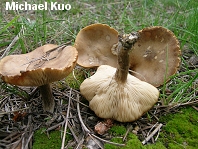| Major Groups > Gilled Mushrooms > Pale-Spored > Melanoleuca > Melanoleuca angelesiana |

|
Melanoleuca angelesiana [ Basidiomycetes > Agaricales > Tricholomataceae > Melanoleuca . . . ] by Michael Kuo Melanoleuca angelesiana will probably require a microscope to identify with certainty; it lacks the distinctive, harpoon-like cystidia found on the gills of most Melanoleuca species. It can be separated from Melanoleuca graminicola, which also lacks cystidia, by its habitat under conifers, its larger size, and its dark stem. Out of deference to North American authorities I am using the name Melanoleuca angelesiana, coined by A. H. Smith, but I have a serious hunch that this North American "species" is morphologically inseparable from the European Melanoleuca stridula. I must admit, however, that the European species is described as a grass and disturbed ground mushroom, while the North American mushroom appears to love western conifers--though McNeil (2006) uses the European name for a species meeting the morphological requirements in Quebec, and his photo features conifer debris around the mushrooms. Gillman & Miller (1977) describe the mushroom featured here as "Melanoleuca graminicola"; Miller later revised the name to Melanoleuca angelesiana in Bessette, Miller, Bessette & Miller (1995). Description: Ecology: Probably saprobic; found under conifers in the western mountains; often appearing in spring near melting snowbanks, but also fruiting as late as August at high elevations. McNeil (2006) reports Melanoleuca stridula in Quebec, in edge woods or in forests, in fall. Cap: 5-11 cm across; convex becoming flat, often with a shallow or fairly prominent central bump; smooth; tacky when fresh; dark brown, fading to tan. Gills: Attached to the stem; crowded; grayish to whitish, sometimes developing slightly pinkish hues. Stem: 5-7 cm long; up to 1.5 cm thick; firm; more or less equal; dry; fairly smooth; whitish at the apex but brown like the cap below; basal mycelium white. Flesh: Whitish in cap and in stem. Odor and Taste: Not distinctive. Spore Print: White. Chemical Reactions: KOH on cap surface negative. Microscopic Features: Spores 7-10 x 4.5-6 µ; more or less elliptical; ornamented with amyloid warts. Pleurocystidia absent; large, projecting cheilocystidia absent. Pileipellis hyphae often with brown contents in a KOH mount. REFERENCES: A. H. Smith, 1944. (Gillman & Miller, 1977 [as M. graminicola]; Smith, Smith & Weber, 1979; Bessette, Miller, Bessette & Miller, 1995; McNeil, 2006 [M. stridula].) Herb. Kuo 09010608. This site contains no information about the edibility or toxicity of mushrooms. |
© MushroomExpert.Com |
|
Cite this page as: Kuo, M. (2007, May). Melanoleuca angelesiana. Retrieved from the MushroomExpert.Com Web site: http://www.mushroomexpert.com/melanoleuca_angelesiana.html |
